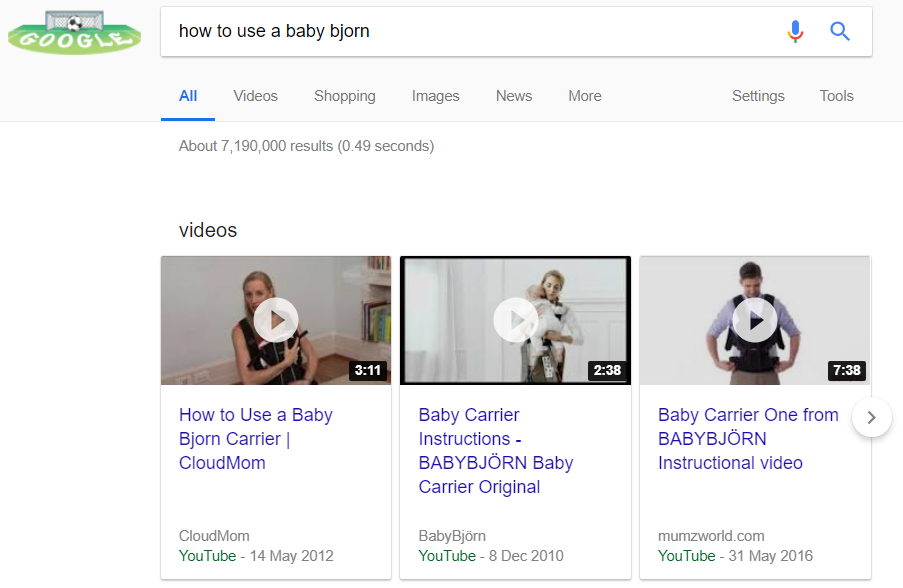When it comes to being visible online, video content is increasingly proving its worth as a way to grab attention and – crucially – to engage meaningfully with internet users.
Videos are engaging growing numbers of users and are consequently having an impact on the SERPs. Forrester estimates that the chances of getting a page one spot on Google increases by 53 times with video. This also translates into clicks; video has been seen to boost traffic from organic listings by as much as 157%.
Video is appearing in an increasing range of contexts and the type of video content available to marketers – such as live streaming, 360 and virtual reality (VR) – is diversifying. So how is the way we search for video changing?
YouTube: the video search engine?
YouTube is the second most popular site in the world according to Alexa. It receives around 30m visits per day.
The behavior of its users also proves the stickiness of video content. Visitors on average spend more than 8 minutes on YouTube per day, and each visit takes in an average of over four pages on the site.
However, YouTube’s popularity and high rates of engagement do not mean that all these users are coming to the site and using its search tool to find the content they need. We know enough about YouTube behavior to understand traffic is most likely to enter the site via a link to a certain video (often from Google) and that users frequently navigate on-site by clicking the suggested videos in the sidebar or watching what the service autoplays next.
That said, there is some research out there to highlight how big a search engine YouTube is.
Back in 2017, Moz and Jumpshot looked at (US only) data which split up Google’s properties and included other leading sites (e.g. Amazon) in an effort to better understand search behaviors. Of ten sites, YouTube ranked third for search share with 3.71% of searches. This is lower than Google.com and Google Images, but ahead of Yahoo!, Bing and Facebook.
Video and Google Search
While 3.71% may seem like a relatively small piece of the pie, when we remember the scale of search activity, YouTube certainly holds its own as a property of this type.
While it is important to understand ranking, visibility and optimization with regard to YouTube’s SERPs, search marketers also need to be aware of the importance of Google. YouTube gets more than 16% of its traffic from search and nearly two out of every hundred clicks on Google’s search results pages goes to a YouTube video.
And we can expect this relationship between the two platforms to get stronger.
Google has owned YouTube for more than 10 years and it’s unsurprising that the clear majority of videos the service includes in its SERPs are hosted there. The search engine is also constantly exploring ways for displaying video results in an increasingly rich and intuitive way.
The above example for the search “how to use a baby bjorn” shows the rich feature video carousel in the top position of the SERPs. As we might expect, all of these results are from YouTube.
[For more analysis of YouTube and Google Video SERPs see Amanda DiSilvestro’s great piece published last autumn.]
Alternative options and alerting Google to video hosted on your own site
It doesn’t take too much time searching for video on Google to see that there are alternatives to YouTube. In the first case, there are a number of direct competitors to the service.
Vimeo, for example, has marked itself out as a quality high definition alternative to other video platforms, even while YouTube et al have made moves to offer HD too. Similarly, Amazon-owned Twitch specializes in live-streaming and is a key destination for millions of gaming fans worldwide. Live-streaming certainly happens elsewhere, but Twitch has succeeded within that niche.
Marketers don’t necessarily need to upload video to YouTube or other similar sites in order to be ranked in Google’s SERPs. With suitable on-page markup and sitemaps, video can be hosted on your own site and Google will have a good chance (though nothing is guaranteed!) at indexing this content for relevant searches. Of course, these videos need to be well-optimized with regard to their title, description and thumbnail too. [There’s more information about on-site video optimization here.]
Social video
When researching competitors to YouTube, we should also look at social media platforms; how video content is being shared by marketers and brands within their feeds, and how users are finding video on these platforms.
Back in February, HubSpot published some interesting data looking into how social channels are increasingly becoming destinations for video across selected markets.
While YouTube is clearly seen to be the dominant place to watch video online, Facebook is showing signs of catching up. This is particularly the case in the Latin American markets, where Facebook reaches more than 300m people.
Like Google, Facebook is responding to the desire its users have for watching video. This is reflected when searching on the service, with playable content being very clickable and dominant when making searches, and users also being able to filter video results. Around 1.5bn searches occur on Facebook every day.
The service is also increasingly keen to promote live video content, as well as emerging types of rich video content such as 360 and VR with its Facebook360 arm.
The challenge for Facebook regarding how it delivers content to users via its site search function, is that it needs to balance content uploaded from within the friend networks of its users, with other public posts – and of course it’s keen to favor the former. It is also a closed ecosystem, and will only crawl content that has been shared within the platform.
This is great opportunity for marketers, though. They can work to create video content that is tailored for, and visible in, the Facebook newsfeed. But this content also needs to be searchable within the platform by ensuring key phrases are used in posts. It is a relatively uncompetitive ecosystem in that regard – especially compared with YouTube and Google.
Predictions for the future of video search
Video and search is a fascinating area. It’s fair to say that looking at YouTube, Google and Facebook is just scraping the surface when speculating how the landscape is likely to change.
Social platforms are undoubtedly seeing more video content hit their feeds. This is coming from the users themselves, but also from the brands and marketers wanting to engage with them. It is so important for social media channels to have engaged users, so it’s understandable that they want to promote the use of video in that context.
Additionally, we know that YouTube and Google depend on each other – and we can expect they will continue to do so. Even when social channels can start matching YouTube for video viewer numbers, it is always going to be difficult for videos shared via social channels to compete with YouTube in Google’s SERPs. The same goes for alternative video platforms and even perfectly optimized on-site video with great markup. YouTube always seems to have the edge in Google, and it looks set to stay that way for the time being.
But technologies and behaviors do change. One way Google is forced to make non-YouTube video content visible is when users are searching for a niche – such as the Live TV game streaming found on Twitch or HD content found on Vimeo. Users may well begin circumventing searching for video content on Google/YouTube altogether should Facebook and other social platforms really succeed in being ‘the platform’ for 360 and VR video content.
With new video technologies always emerging, and with 5G and the Internet of Things just around the corner, web properties that can be the first to really succeed in pushing other types of video content before YouTube will see searchers come to them first. YouTube, with the help of Google, may continue to dominate, but it can’t be all things to all people in the world of video.
Luke Richards is a Search Engine Watch columnist.
from Search Engine Watch https://ift.tt/2KqIWPC






No comments:
Post a Comment